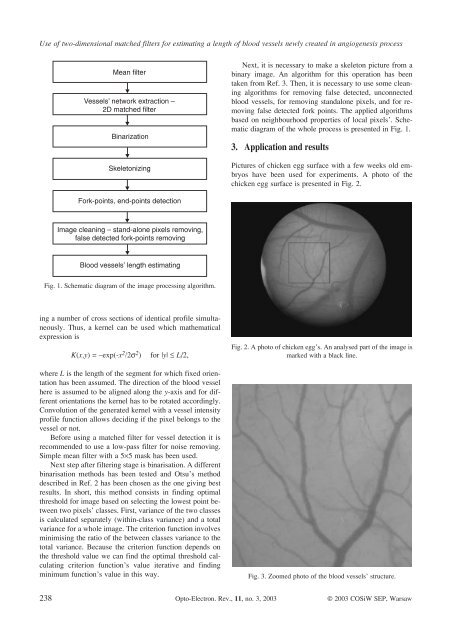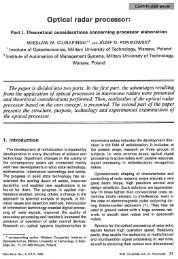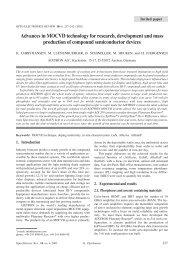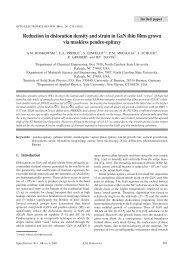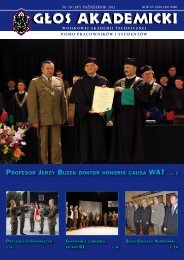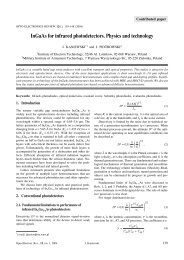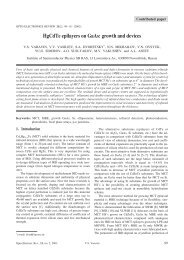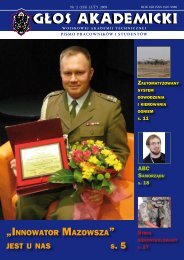Use of two-dimensional matched filters for estimating a length of ...
Use of two-dimensional matched filters for estimating a length of ...
Use of two-dimensional matched filters for estimating a length of ...
You also want an ePaper? Increase the reach of your titles
YUMPU automatically turns print PDFs into web optimized ePapers that Google loves.
<strong>Use</strong> <strong>of</strong> <strong>two</strong>-<strong>dimensional</strong> <strong>matched</strong> <strong>filters</strong> <strong>for</strong> <strong>estimating</strong> a <strong>length</strong> <strong>of</strong> blood vessels newly created in angiogenesis processNext, it is necessary to make a skeleton picture from abinary image. An algorithm <strong>for</strong> this operation has beentaken from Ref. 3. Then, it is necessary to use some cleaningalgorithms <strong>for</strong> removing false detected, unconnectedblood vessels, <strong>for</strong> removing standalone pixels, and <strong>for</strong> removingfalse detected <strong>for</strong>k points. The applied algorithmsbased on neighbourhood properties <strong>of</strong> local pixels’. Schematicdiagram <strong>of</strong> the whole process is presented in Fig. 1.3. Application and resultsPictures <strong>of</strong> chicken egg surface with a few weeks old embryoshave been used <strong>for</strong> experiments. A photo <strong>of</strong> thechicken egg surface is presented in Fig. 2.Fig. 1. Schematic diagram <strong>of</strong> the image processing algorithm.ing a number <strong>of</strong> cross sections <strong>of</strong> identical pr<strong>of</strong>ile simultaneously.Thus, a kernel can be used which mathematicalexpression isK(x,y) = –exp(-x 2 /2s 2 )<strong>for</strong> |y| £ L/2,where L is the <strong>length</strong> <strong>of</strong> the segment <strong>for</strong> which fixed orientationhas been assumed. The direction <strong>of</strong> the blood vesselhere is assumed to be aligned along the y-axis and <strong>for</strong> differentorientations the kernel has to be rotated accordingly.Convolution <strong>of</strong> the generated kernel with a vessel intensitypr<strong>of</strong>ile function allows deciding if the pixel belongs to thevessel or not.Be<strong>for</strong>e using a <strong>matched</strong> filter <strong>for</strong> vessel detection it isrecommended to use a low-pass filter <strong>for</strong> noise removing.Simple mean filter with a 5´5 mask has been used.Next step after filtering stage is binarisation. A differentbinarisation methods has been tested and Otsu’s methoddescribed in Ref. 2 has been chosen as the one giving bestresults. In short, this method consists in finding optimalthreshold <strong>for</strong> image based on selecting the lowest point between<strong>two</strong> pixels’ classes. First, variance <strong>of</strong> the <strong>two</strong> classesis calculated separately (within-class variance) and a totalvariance <strong>for</strong> a whole image. The criterion function involvesminimising the ratio <strong>of</strong> the between classes variance to thetotal variance. Because the criterion function depends onthe threshold value we can find the optimal threshold calculatingcriterion function’s value iterative and findingminimum function’s value in this way.Fig. 2. A photo <strong>of</strong> chicken egg’s. An analysed part <strong>of</strong> the image ismarked with a black line.Fig. 3. Zoomed photo <strong>of</strong> the blood vessels’ structure.238 Opto-Electron. Rev., 11, no. 3, 2003 © 2003 COSiW SEP, Warsaw


